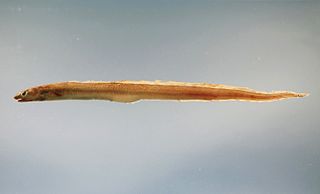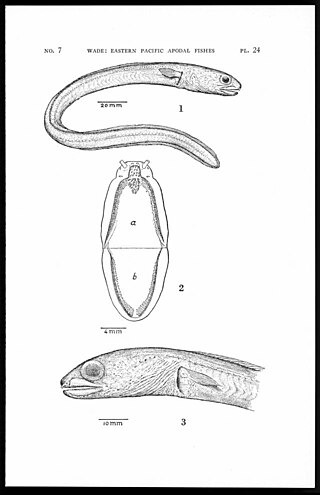
Conger is a genus of marine congrid eels. It includes some of the largest types of eels, ranging up to 2 m (6 ft) or more in length, in the case of the European conger. Large congers have often been observed by divers during the day in parts of the Mediterranean Sea, and both European and American congers are sometimes caught by fishermen along the European and North American Atlantic coasts.

The Congridae are the family of conger and garden eels. Congers are valuable and often large food fishes, while garden eels live in colonies, all protruding from the sea floor after the manner of plants in a garden. The family includes over 220 species in 32 genera.
Gnathophis is a genus of marine congrid eels.

Leptocephalus is a genus that was used for species of larval eels, called leptocephali. Leptocephali larvae differ so much in appearance from their adults. When first discovered, leptocephali were thought to be a distinct type of fish, not an eel specie. Because of this, the genus designation of Leptocephalus was used for a while for an unidentified leptocephali. After it was known that these were eel larvae, it was identified to be part of a wastebasket taxon, but not anymore in the present classification system. Examples of marine congrid larvae, found in the western Indian Ocean and the Red Sea that were named this way are listed below. Only two species in two families are currently treated as having any validity, though the validity of L. bellottii is strongly in doubt.

Eels are ray-finned fish belonging to the order Anguilliformes, which consists of eight suborders, 20 families, 164 genera, and about 1000 species. Eels undergo considerable development from the early larval stage to the eventual adult stage and are usually predators.

Ariosoma is a genus of marine congrid eels.
Bathycongrus is a genus of eels in the family Congridae.

Paraconger is a genus of eels in the family Congridae. It currently contains the following species:

Rhynchoconger is a genus of eels in the family Congridae.
Hoplunnis is a genus of eels in the duckbill eel family Nettastomatidae. It currently contains the following species:

The Congrinae are a subfamily of eels in the family Congridae.
The slope conger, also known as the black-fin conger, is an eel in the family Congridae. It was described by Charles Henry Gilbert in 1891, originally under the genus Ophisoma. It is a marine, deep water-dwelling eel which is known from the southeastern and eastern central Pacific Ocean, including Colombia, Ecuador, Costa Rica, Honduras, El Salvador, Mexico, Guatemala, Nicaragua, Panama, and Peru. It is known to dwell at a depth range of 380–740 metres, and inhabits substrates. Males can reach a maximum total length of 35 centimetres.
The neighbor conger is an eel in the family Congridae. It was described by Samuel Garman in 1899, originally under the genus Uroconger. It is a marine, deep water-dwelling eel that is known from the southwestern and western central Atlantic Ocean, including the Bahamas, Brazil, Cuba, and Mexico. It dwells at a depth range of 101–503 metres (331–1,650 ft). Males can reach a maximum total length of 46.2 centimetres (18.2 in).

The large-toothed conger is an eel belonging to the family Congridae. It was described by Léon Vaillant in 1888, originally as a species of the genus Uroconger.
Paruroconger is a monospecific genus of marine ray-finned fish belonging to the subfamily Congrinae, the conger eels, in the family Congridae, which also includes the[[garden eel]s. The only species in the genus is Paruroconger drachi, an eel which is known only from the holotype collected in the Eastern Atlantic Ocean off Pointe-Noire in the Republic of Congo.
Uroconger erythraeus is an eel in the family Congridae. It was described by Peter Henry John Castle in 1982. It is a marine, deep water-dwelling eel which is known from the Red Sea, in the western Indian Ocean. It is known to dwell at a depth range of 820 to 1,550 metres.
The slender conger is an eel in the family Congridae. It was described by John Richardson in 1845, originally under the genus Congrus. It is a marine, tropical eel which is known from the Indo-Western Pacific Ocean, including the Red Sea, South Africa, and Japan. It dwells at a depth range of 18 to 760 metres, and inhabits sand and mud. Males can reach a maximum total length of 52 centimetres (20 in), but more commonly reach a TL of 30 centimetres (12 in).
The yellow pike conger is a species of marine ray-finned fish belonging to the family Muraenesocidae, the pike congers. This fish is found in the Indian Ocean and the western Pacific Ocean.
The threadtail conger is an eel in the family Congridae. It was described by Isaac Ginsburg in 1954. It is a marine, subtropical eel which is known from the eastern and western Atlantic Ocean, including the Gulf of Guinea, the Gulf of Mexico and Suriname. It is known to dwell at a depth range of 44 to 384 meters. Males can reach a maximum total length of 38 centimeters (15 in).








